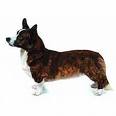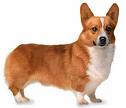
Adran D
Section D
THE WELSH CORGI
 Cardiganshire Cardiganshire |
 Pembrokeshire Pembrokeshire |
Recent publicity has highlighted the diminishing popularity of the Welsh Corgi - the Cardiganshire corgi in particular is now on the endangered list of extinction.
The Welsh Corgi is a small breed of dog that originated in Wales. Cor gi means "dwarf dog" in Welsh.
Originally bred for herding sheep and cattle, Corgis
are active dogs, and considered very intelligent. They have proven
themselves
excellent
companion animals and are outstanding competitors in sheepdog trials
and agility trials.
The Pembroke Welsh Corgi has three predominant types of coloring:
Red and white, Sable and Tri-Color. Despite their small size, Corgis
are active and playful dogs, similar to other herding breeds.
Welsh Corgi appearance
-
Build: Long and low (Two types: Pembroke and Cardigan; the Cardigan is somewhat heavier
-
Weight: 25-30 pounds (11-14kg)
-
Height: 10-12 inches (25-30cm)
-
Coat: Soft, water-resistant
-
Color: Black & tan, black & brindle, sable, and red, often with white markings; Cardigan has also brindle, blue merle, black, black & brindle.
-
Head: A broad flat skull and a fox-like head
-
Teeth: Scissors bite
-
Eyes: Dark, with black rims
-
Ears: Large erect ears; Cardigan’s are larger
-
Tail: Cardigan has long, low-set tail; Pembroke has none
-
Limbs: Short, heavily boned; Pembroke has straighter legs
-
Feet: Pembroke’s are more round
-
Life span: Median 12-15 years
An average Welsh Corgi is around 10 to 12 in (25 to 30 cm) tall at the tallest point in the shoulders and weighs approximately 24-30 lb (12-15 kg).
Welsh Corgis are generally recognized as two distinct breeds: the Cardigan and the Pembroke. Beginning in 1934, the American Kennel Club recognized them as separate breeds. The Cardigan is the larger of the two, with larger rounded ears and a foxy, flowing tail. The Pembroke features rounded, pointed ears and is somewhat smaller in stature. Historically, the Pembroke was a breed with a natural bob tail (very short tail). Due to the advent of docking, the trait was not aggressively pursued, with breeders focusing instead on other characteristics, and the tail artificially shortened if need be. Given that some countries are now banning docking, breeders are again attempting to select for dogs with the genes for natural bob tails. The coats of both breeds come in a variety of colors, although there are some differences between the breeds.
The Pembroke remains the more common variety. Outside Wales, the breed has been made popular by Queen Elizabeth II of the United Kingdom, who keeps at least four at all times.
Corgis are extremely active and loyal dogs. They are highly intelligent and very obedient. As they are loyal to their owners they make excellent watch dogs. They make good companion dogs. Due to their herding instinct, they may nip hands and feet gingerly, but this can easily be trained out. Also, they are known for being very good with commands. They enjoy a regimen of daily activities; things as small as getting the morning paper will make your corgi feel that their 'task' has been accomplished for the day. Corgis are very strong willed dogs and need a master who can take charge.
Both the Cardigan and Pembroke Welsh Corgi are among the healthiest and longest-lived dogs in the Herding Group. The Cardigan tends to be a little hardier and has fewer documented hereditary health issues. Cardigan Welsh Corgis have a typical life expectancy between 12 and 14 years, and Pembroke Welsh Corgis typically live between 11 and 13 years.